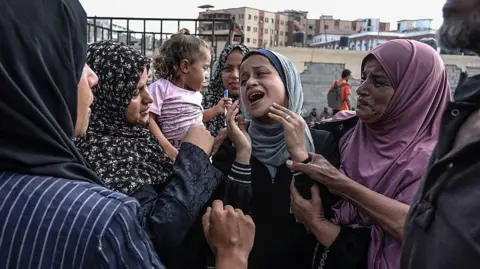In the latest conflict in Gaza, renewed violence has tragically resulted in the loss of at least 32 Palestinian lives. This loss occurred near two sites designated for aid distribution in the regions of Khan Younis and Rafah, as reported by the Hamas-run health ministry in Gaza. The casualties are a reflection of the ongoing turmoil and dire humanitarian crisis unfolding in this contested territory.
Eyewitness accounts indicate that the Israeli Defense Forces (IDF) opened fire on individuals seeking food aid, with reports suggesting that the shots appeared to be purposefully aimed, rather than mere crowd control measures. This incident has drawn serious allegations regarding the conduct of Israeli troops, as many on the ground claim the gunfire has been directed with lethal intent. It is exacerbated by the well-documented instances of violence that have occurred since the Gaza Humanitarian Foundation (GHF) began its operations in late May.
According to the GHF, no incidents were reported at their facilities, yet they admitted to witnessing Israeli military operations in the vicinity just prior to the scheduled distribution of aid. This raises questions about the coordination, timing, and safety of humanitarian efforts in an area heavily impacted by conflict and insecurity. Concerns have been voiced by aid workers who noted that their colleagues sometimes felt compelled to shoot at hungry crowds, underscoring the high-stakes environment in which humanitarian efforts are being conducted.
The events have led to an influx of wounded individuals at local medical facilities. Reports from the Palestinian ministry of health indicate that several bodies were brought to nearby Nasser hospital after the shoot-out. Amid these incidents, there have been nearly daily reports of fatalities involving Palestinians seeking food. The circumstances surrounding these incidents have led to growing international scrutiny of Israeli military actions in the region.
Further complicating the situation, Mohammed Al-Khalidi, an eyewitness, attributed the violence directly to the Israeli army. He claimed that tanks advanced as crowds gathered for aid distribution, reinforcing the narrative that the gunfire was not solely a reactionary measure. Al-Khalidi vividly described the experience, contrasting the aim of the shots with rather than attempts to disperse or organize the crowd.
As this humanitarian crisis deepens, the nature of the GHF’s operational framework has come under scrutiny. It employs private security contractors for the distribution of aid within Israeli military zones, justified by claims that it is necessary to prevent Hamas from siphoning off critical supplies. However, the United Nations has raised strong objections to this method, denying cooperation and characterizing it as fundamentally unethical. The statistics provided by the UN human rights office further highlight the concerns surrounding safety in the region, with reports documenting 674 deaths at or near GHF sites over a span of six weeks.
Despite these alarming figures, the GHF has insisted that no deadly incidents occurred near their facilities. They have challenged the validity of figures provided by the Hamas-run health ministry, arguing that these counts are often exaggerated. The ongoing conflict is further exacerbated by restrictions imposed by the Israeli government, preventing international journalists from operating within the territories and contributing to a lack of independent verification.
In addition to the violence, a critical humanitarian crisis is evident as the United Nations reported a doubling of severely malnourished children since food restrictions began in March. The GHF’s efforts to provide assistance are hindered by significant blockages at border crossings, preventing essential supplies like baby formula from reaching those in need. Reports indicate that an alarming number of children are succumbing to malnutrition, with as many as 69 fatalities documented in the last week alone.
Finally, talks of a ceasefire have been put forth by U.S. President Donald Trump, yet a Palestinian official indicated that progress remains stalled. Even so, the lack of actionable change only underlines the need for urgent international intervention given the dire situation facing the people of Gaza. As the humanitarian needs increase and violence persists, the complex dynamics of this longstanding conflict continue to challenge any path toward peace and stability.











